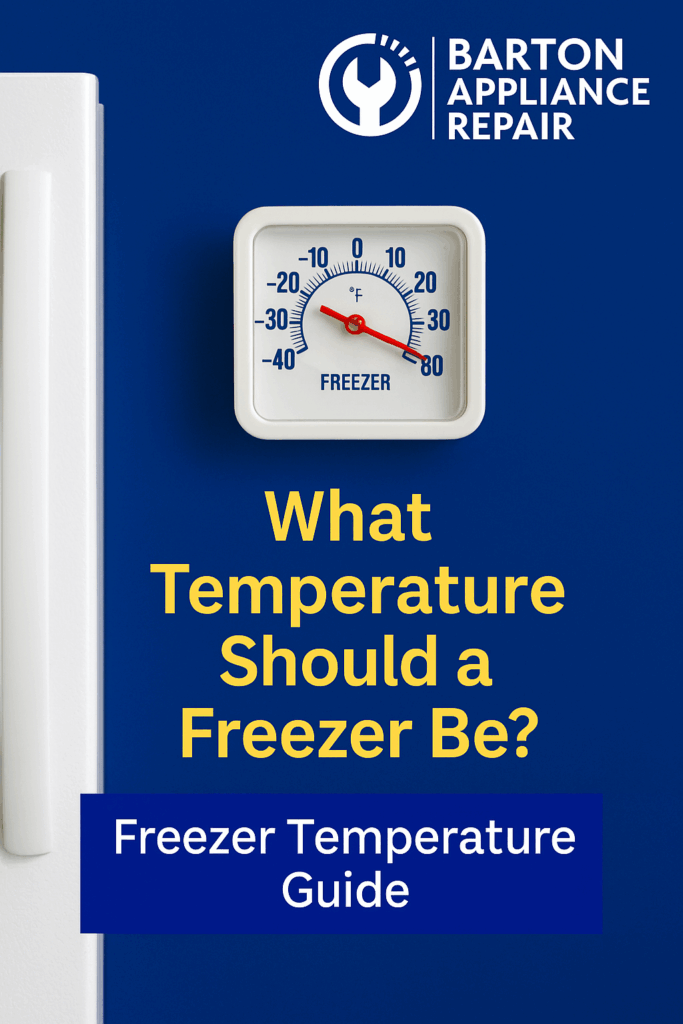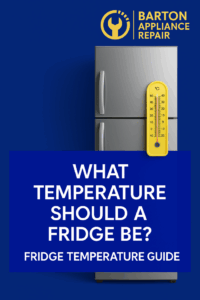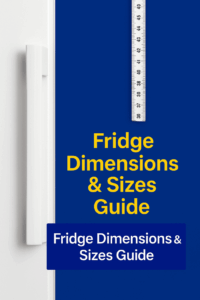The freezer is one of the most essential pieces of equipment in every kitchen; unless it’s set to the proper temperature, it won’t perform its job. Too warm, and food safety comes into question. Too cold, and you’re wasting energy for no additional benefit. Finding the correct balance isn’t merely a matter of keeping things frozen, it’s about protecting taste, nutrition, and a sense of security.
In 2025, with smarter freezers and increasingly mindful households about electricity consumption and food waste, knowing how to look after your freezer is more beneficial than ever before. This handbook takes you through the perfect temperature for your freezer, why, and the best methods to keep it that way for day-to-day use as well as longer-term storage.
What Is the Ideal Freezer Temperature?
To keep food safely frozen over time, freezers need to be set at 0°F (–18°C).
This temperature is recognised by the U.S. Food Safety Inspection Service (FSIS) and the Food and Drug Administration (FDA). According to them, this temperature reduces microbial activity that usually leads to spoilage and illness. The quality of food also remains protected.
Recent Studies in 2024 have confirmed that maintaining a consistent temperature at or below 0° F provides ideal conditions for long-term food storage. This also makes sure that there is less nutrient degradation and texture changes over time.
Why Proper Freezer Temperature Matters?
Food Safety Assurance
At 0°f, harmful microorganisms enter a sleeping state. In this, they are unable to multiply and produce toxins. Although freezing doesn’t remove the existing bacteria, it prevents further growth and development. The FDA Food Code highlights that maintaining consistent freezer temperatures is an important control point in home safety management.
Nutritional Value Preservation
Research published in the Journal of Food Science (2024) proves that foods stored at the ideal freezer temperature keep more nutrients than those kept at fluctuating or higher temperatures:
- Frozen vegetables maintain up to 95% of their vitamin C when stored at a consistent 0°f.
- Protein-rich foods protect their amino acids better.
- Antioxidant compounds in frozen berries show only slight degradation after 12 months at proper temperatures.
Freezer Burn Prevention
Maintaining the ideal freezer temperature reduces the chances of freezer burn. It is the dehydration and oxidation that happens when food is exposed to air in a freezing environment. While technically it is safe to eat, freezer-burned food suffers from:
- Compromised texture
- Loss of flavour
- Reduced juiciness
- Diminished visual appeal
Energy Optimization
Modern freezers (2023-2025 models) are designed to work most efficiently at 0° F temperature. Setting your freezer colder than necessary increases energy consumption and doesn’t give additional benefits. According to the U.S. Department of Energy, every degree below 0°f can increase energy usage by approximately 2-3%.
Related: What Temperature Should a Fridge Be? Fridge Temperature Guide
Methods for Monitoring Freezer Temperature
Use Dedicated Appliance Thermometers
For accurate temperature monitoring, placement matters:
- Position thermometers in the center of the middle shelf, not against the walls.
- For chest freezers, keep them near the top where temperature fluctuations are noticeable.
- Digital thermometers with external displays allow checking without opening the door.
Fact: Modern smart thermometers introduced in 2024-2025 can connect to your home network. With this, they can send alerts when the temperature changes.
Proper Loading Techniques
Strategic Placement
- A well-stocked freezer maintains temperature better during power outages
- Leave approximately 20% free space for air circulation
Organisation by Category
- Group similar items together to minimise cold air loss when getting specific foods
- Place frequently used items at the front for quick access
Strategic Access Habits
Each time you open your freezer, cold air escapes and warm air enters:
- Plan before opening the door
- Organise contents logically so items can be located quickly
- Keep a freezer inventory list (digital apps for this purpose have been popular)
Systematic Maintenance Schedule
For best performance:
- Quarterly: Check door seals for cracks or wear
- Biannually: Clean condenser coils
- As needed: For manual defrost models, do it when frost goes beyond ¼ inch thickness.
- Yearly: Schedule professional maintenance for commercial or high-end units
Advanced Food Freezing Techniques
Cooling Preparation
- Cold hot foods completely in the fridge before putting them in the freezer
- Divide large portions into smaller containers to speed cooling
- Never place hot food directly (raises freezer temperature)
Blanching Benefits
- Briefly immerse vegetables in boiling water before freezing
- Stops enzyme activity that can cause loss of flavour, colour, and texture
- Quick-cool in ice water immediately after blanching
Pre-Freezing Techniques
- Pre-freeze berries and cut fruits on baking sheets before packing to prevent clumping
- Flash-freeze individual portions of sauces or soups in ice cube trays
- Chill fatty meats briefly before vacuum sealing to prevent moisture loss
Updated Packaging Recommendations
The latest packaging innovations for 2025 include:
- Vacuum-sealed containers that remove 99% of air
- Reusable silicone freezer bags that reduce environmental impact
- Portion-sized containers that minimise the need to thaw excess food
- Specialised freezer paper with improved moisture and vapour barriers
Fact: The less air in contact with frozen food, the better it will maintain quality over time.
Digital Organisation Systems
Coming trends in 2025 for freezer management:
- QR code labelling systems that link expiration dates and cooking instructions.
- Smart inventory apps that track freezer contents and suggest recipes.
- Colour-coded storage systems for different food categories and storage durations.
Definitive Storage Duration Guidelines (2025 Update)
Even though frozen foods remain safe when maintained at 0°f, their quality reduces over time. These are the guidelines that tell you the best storage periods for maintaining premium taste, texture and nutritional value:
| Food Category | Item | Optimal Storage Time |
| Meat | Beef, lamb, pork (roasts/steaks) | 10-12 months |
| Ground meats | 3-4 months | |
| Poultry (whole) | 12 months | |
| Poultry (parts) | 9 months | |
| Fish (fatty) | 2-3 months | |
| Fish (lean) | 6 months | |
| Prepared Foods | Soups and stews | 2-3 months |
| Casseroles | 3 months | |
| Cooked meats and poultry | 2-3 months | |
| Pizza | 1-2 months | |
| Other Items | Bread and baked goods | 3 months |
| Fruits and vegetables | 8-12 months | |
| Ice cream | 2 months | |
| Butter | 6-9 months |
Emergency Preparedness: Power Outage Protocol
The increasing frequency of severe weather events has pointed to how important it is to make freezer emergency plans:
- Keep freezers closed during outages to maintain the temperature(a full freezer maintains safe temperatures for 48 hours, half-full for 24 hours).
- Use temperature sensors that record maximum temperatures reached during outages.
- Check for ice crystals: Foods with ice crystals or that feel refrigerator-cold (40°f or below) can be safely refrozen.
- Apply the two-hour rule: Foods that get easily spoiled held above 40° F for more than 2 hours should be thrown.
- Consider backup power options: New generation battery backups designed specifically for refrigeration appliances have become more affordable in 2025.
Common Freezer Temperature Mistakes to Avoid
Setting Too Cold
- Setting below 0°f wastes energy without food safety benefits
- Can cause freezer burn to more of some foods
Overcrowding Shelves
- Blocks air circulation, leading to warm spots
- Makes it difficult to find items, increasing door-open time
Neglecting Regular Checks
- Temperature can drift over time without being noticed
- Seasonal ambient temperature changes may require adjustments
Improper Defrosting
- Allowing frost buildup reduces efficiency
- Using sharp objects to remove ice can damage freezer parts
Freezer Temperature Quick Reference
| Essential Information | Details |
| Ideal Freezer Temperature | 0F (-18C) |
| Check Frequency | Weekly |
| Full Freezer Power Outage Safety | Up to 48 hours (unopened) |
| Half-Full Freezer Power Outage Safety | Up to 24 hours (unopened) |
| Food Safety Threshold | Remove foods held above 40F for >2 hours |
Related: How to Clean Your Dryer Vent in 8 Easy Steps
Conclusion: Freezer Temperature Mastery
Maintaining your freezer at the ideal freezer temperature of 0°f (-18C) is best for protecting your food. Combine this optimal temperature setting with proper packaging, organization, and monitoring techniques. Then, you can make sure of maximum food safety, quality protection, and energy efficiency. For the latest updates on food safety guidelines and freezer management, consult the FDA’s regularly updated resources or your freezer manufacturer’s specific recommendations.





